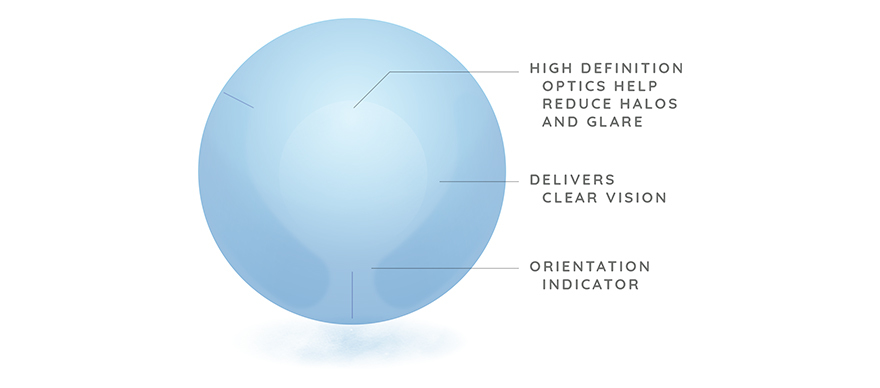Biotrue ONEday for Astigmatism has been designed for modern life, with a 78% water content, and the ability to maintain 98% of its moisture throughout the day - up to 16 hours 2, you can be confident that even long hours of screen time won't dry out your lenses.
Astigmatism remains one of the most common conditions Optometrists treat on a daily basis. According to research by Johnson and Johnson, 47% of optical patients have astigmatism.3 With Biotrue ONEday for Astigmatism, people with astigmatism can now wear a contact lens that provides great comfort, allows enough oxygen through to your eyes to keep them healthy and white, whilst reducing halos and glares particularly at night or when staring at a screen.
Good To Know
Are Biotrue ONEday for Astigmatism and Biotrue ONEday For Presbyopia The Same Thing
No, Biotrue ONEday for Astigmatism has been design to correct the effects of astigmatism, which is a structural disorder in the eye or eyes that often causes blurry vision, whilst Biotrue ONEday for Presbyopia has been designed to correct the effects of presbyopia which is a visual condition that most of us will eventually experience as we age, it affects our ability to focus on object or writing close up.
Why Do I Need Toric Contacts Lenses?
Toric contact lenses have been designed to correct astigmatism, which is a structural disorder in the eye or eyes that often causes blurry vision.
Toric contacts are specifically designed to address the abnormal shape of the cornea (corneal astigmatism) or lens (lenticular astigmatism) by altering the focusing power, they are also stabilised either by a thickening or a weighting at the bottom of the lens to provide stability during blinking to help create a smooth, clear visual experience which cannot be achieved with regular contact lenses.
Are Biotrue ONEday For Astigmatism A Silicone Hydrogel Contact Lens
No, Biotrue ONEday for Astigmatism are a regular hydrogel daily disposable contact lens, but due to their high water content (78%) and their breakthrough Surface Active Technology™ they can provide most of the benefits of a silicone hydrogel lens- breathability, comfort and long wear times- whilst remaining hydrophilic.
What Is Astigmatism
Astigmatism is a structural disorder in the eyes that often causes blurry vision. The principal structure that’s affected in most astigmatic patients is the cornea, which refers to the clear layer that sits just over the pupil and iris.
In non-astigmatic eyes, the corneas will be both smooth and spherical, thus allowing light to enter the eyes evenly. Astigmatic eyes, however, often have unevenly shaped corneas that warp how light penetrates the retina. It is commonly referred to as a 'rugby ball' shaped eye - however, it is very subtle, you cannot see it by looking at your eye.
There are two categories of Astigmatism: Regular and Irregular.
Regular astigmatism
There is some evidence that suggests that regular astigmatism may be hereditary in nature, passing from parents to their children, but there's not enough information available to know for certain.
Irregular astigmatism
Often caused by damage to the eye, resulting in corneal scarring, or scattering within the crystalline lens inside the eye.
The Essentials
Manufacturer: Bausch and Lomb
Brand: Biotrue
Wearing Type: Toric, Daily Disposable Contact Lenses
Power Range: +4.00 to -9.00
Cyl: -0.75D, -1.25D, -1.75D, -2.25D
Axis: 10°-180° in 10° steps
Base Curve(s): 8.4
Diameter: 14.5
Lens Material: Nesofilcon A
Water Content: 78%
Oxygen Permeability: 42 Dk/t
Handling Tint: Yes
UVA/UVB Protection: Yes.
Quantity Per Box: 30
Availability: 100% availability
Inside Out Indicator: Orientation mark at 6 O’clock
References
1. Study carried out by Bausch and Lomb Biotrue ONEday for Astigmatism - Contact Lenses (bausch.co.uk)
2. Twenty-two subjects participated in a randomised, double-masked, contralateral eye study to evaluate water loss of Biotrue® ONE Day and 1-Day ACUVUE Moist contact lenses. After 4, 8, 12, and 16 hours of wear, lenses were removed and immediately weighed (wet weight). The lenses were then completely dried and reweighed (dry weight). The percent water loss was then calculated for each lens from the wet and dry weights.
3. Study carried out by Johnson and Johnson https://www.jnjvisioncare.co.uk/education/astigmat...

